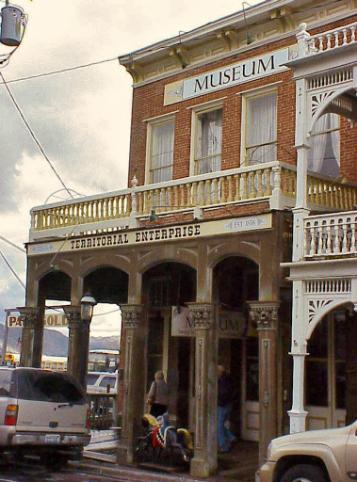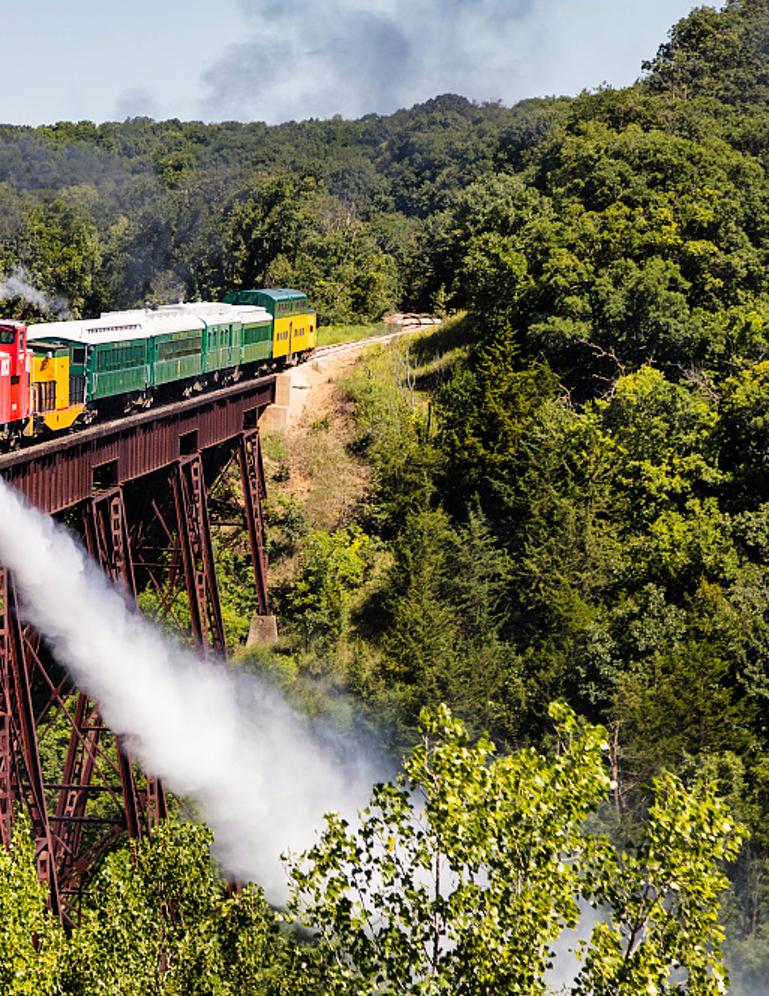
7 minute read
Traveling the Highways & Byways with Bill Graves

Counties were explored. The only line that met the specific needs of the film industry was Southern Pacific’s Santa Paula Branch in rural Ventura County. The Fillmore & Western railyard is located adjacent to the restored city hall in downtown Fillmore, and is part of the revitalized section of the city rebuilt after extensive damage caused by the 1994 Northridge earthquake. The “Movie Trains” found a home and Fillmore became “Train Town”. In 1996, Short Line Enterprises became the film division of the Fillmore & Western Railway Company. Operations expanded from movie work and limited passenger trips to regularly scheduled daytime passenger excursions, Saturday and Sunday lunch/dinner trains, holiday train and other specialty trains. The antique trains of Fillmore & Western rolled into the 21st century. They remain highly involved in the magic of movie making, while the company’s passenger excursions, dinner trains, private party and corporate event trains provide the means of travel to a bygone era.
http://www.fwry.com/index.html#home Byways 27
Virginia City, 150 years ago, was the richest place on earth. It was the crown jewel of Nevada’s Comstock Lode. The jewel was silver, tons of it that flowed into our country’s coffers for 30 years. It funded an estimated $400 million of our young nation’s westward-expansion, and paid the Union Army during the Civil War.
The riches of the Comstock were the reason President Lincoln in 1864 declared statehood to Nevada, long before it had met the population requirement. Built into a steep mountainside, it was a modern town in the 1860s, with theaters, churches, opium dens and newspapers. Indeed, a young reporter at Nevada’s first newspaper, the Territorial Enterprise, made a name for himself here, quite literally. He arrived as Samuel Clemens; when he left 22 months later he was known as Mark Twain. For 25 glorious years, it was the leading city in Nevada and the brightest and most important settlement between Denver and San Francisco. It had the only elevator this side of Chicago.
Today, Virginia City is the largest historic district in the United States. Its old buildings preserved or restored, it’s still a functioning town of private enterprise and remains the seat of county government.

Virginia City, Nevada

With a past as rich as its storied silver vein, its business now is tourism. But that’s just evolved in the last 40 years. When LeRoy Goodman grew up here, in the years after World War II, it was simply an old mining town with no real future. “We were just hanging on then. During the war, county government almost shut down. Most of the men were away in the service,” LeRoy told me. “In 1949, the mine shut down where my dad worked. He was good at fixing things, so he bought a garage. I hung out there out a lot. “It was across the street from the Silver Queen Saloon. When Clark Gable was making the movie Misfits down in Dayton, he’d drive up here from Reno on his way to work and stop in there for a couple shots. He was easy to talk to. He drove a Lamborghini. Its doors swung open from the top like wings. “We had 12 kids in my graduating class. That was a big class. . .38 in the whole school. After school, we usually went to somebody’s house. My mother was the telephone operator so she always knew where we were. She knew where everybody else in town was too. People all the time would pick up the phone and ask her where so and so was. She would know, or ring a few places and find out. “At lunch time, I’d walk home and listen to One Man’s Family on the radio. We all did that. At night we’d hear the The Shadow and The Green Hornet.” Kids grew up here with a wonderful simplicity of desire. They knew one way of life, one standard of living. LeRoy explained it: “We had no doctors or lawyers or anybody here who lived differently than we did. If we were missing out on something, we didn’t know it. “We had a sheriff and one deputy for the whole county. They had it easy. Nobody ever got in trouble. “We were everybody’s kids – even people who didn’t have kids. Heck, they often took us fishing and to ball games in Reno. At Christmas, the Fire Department had a party for us. Every kid in town got a present. “My mother’s telephone switchboard is in the museum now. We had party lines. Each family on the line had a different ring. She knew everybody’s ring. They were like names to her.” Welcome to America’s outback.

About the author: After seeing much of the world as a career naval officer, Bill Graves decided, after he retired, to take a closer look at the United States. He has been roaming the country for 20 years, much of it in a motorhome with his dog Rusty. He lives in Rancho Palos Verdes, California and is the author of On the Back Roads, Discovering Small Towns of America. He can be reached at Roadscribe@aol.com.




The Boone & Scenic Valley Railroad is a heritage and excursion railroad begun in 1983 by a group of volunteers who wanted to preserve a scenic section of the former Fort Dodge, Des Moines and Southern Railroad. The original track was built in the 1890s and electrified in 1907. After massive 1954 flooding damaged the power plant in Fraser, Iowa, which provided electricity to the line, the railroad turned to diesel equipment to pull its trains. The Chicago & North Western purchased the entire Fort Dodge, Des Moines and Southern system in 1968. Shortly after acquiring the line, the Chicago & North Western began to place portions of it up for abandonment. In 1983, an 11-mile section of the line was purchased by the Boone Railroad Historical Society, and its 2254 charter members, for $50,000. The stretch of track winds through the Des Moines River Valley and across a 156-foot tall

bridge spanning Bass Point Creek, a tributary of the Des Moines River. The line runs from Boone, through the old coal mining town of Fraser, and ends at the site of the former junction with the Minneapolis and St. Louis Railway at Wolf. The railroad became an immediate success and has expanded regularly since its founding. A depot was dedicated in 1985. Today, more than 30,000 visitors take a ride on one of the regular or special event trains, including Thomas the Tank Engine




(September), the Pumpkin Express (October), and Santa Express (weekends between Thanksgiving and Christmas) that features a book written and illustrated especially for the trip. Dining cars are reserved for special dinner trains. The James H. Andrew Railroad Museum and History Center was added to the existing depot and dedicated in 2012. It is a 9,000 foot facility featuring a research library and theater.
The museum preserves thousands of Iowa railroad artifacts and memorabilia such as track equipment, toy trains, dining car china, timetables, photos, lanterns, and telegraph equipment. The museum hosts special exhibitions, maintains a research library, and has a small theater/conference room.
https://bsvrr.com/wp/

t



The Maine Narrow Gauge Railroad Co. & Museum is dedicated to the preservation and operation of Maine’s two-foot gauge railway equipment for the education and enjoyment of the public. The leisurely train ride lasts approximately 35 minutes and travels 1.5 miles (3 miles round trip) along the Eastern Promenade of Casco Bay in Portland. Train crew and/or history docents are available to provide historical information aboard the ride. Both open air cars and enclosed cars are available depending on the season. Trains operates rain or shine. Pets are welcome during regular-service train rides provided they are on a leash and well-behaved.
History
Starting in the latter part of the 19th century, Maine had a unique system of railroads that ran on rail only two feet apart. From the 1870s until the 1940s, some 200 miles of narrow gauge lines served many of Maine’s smaller communities.




